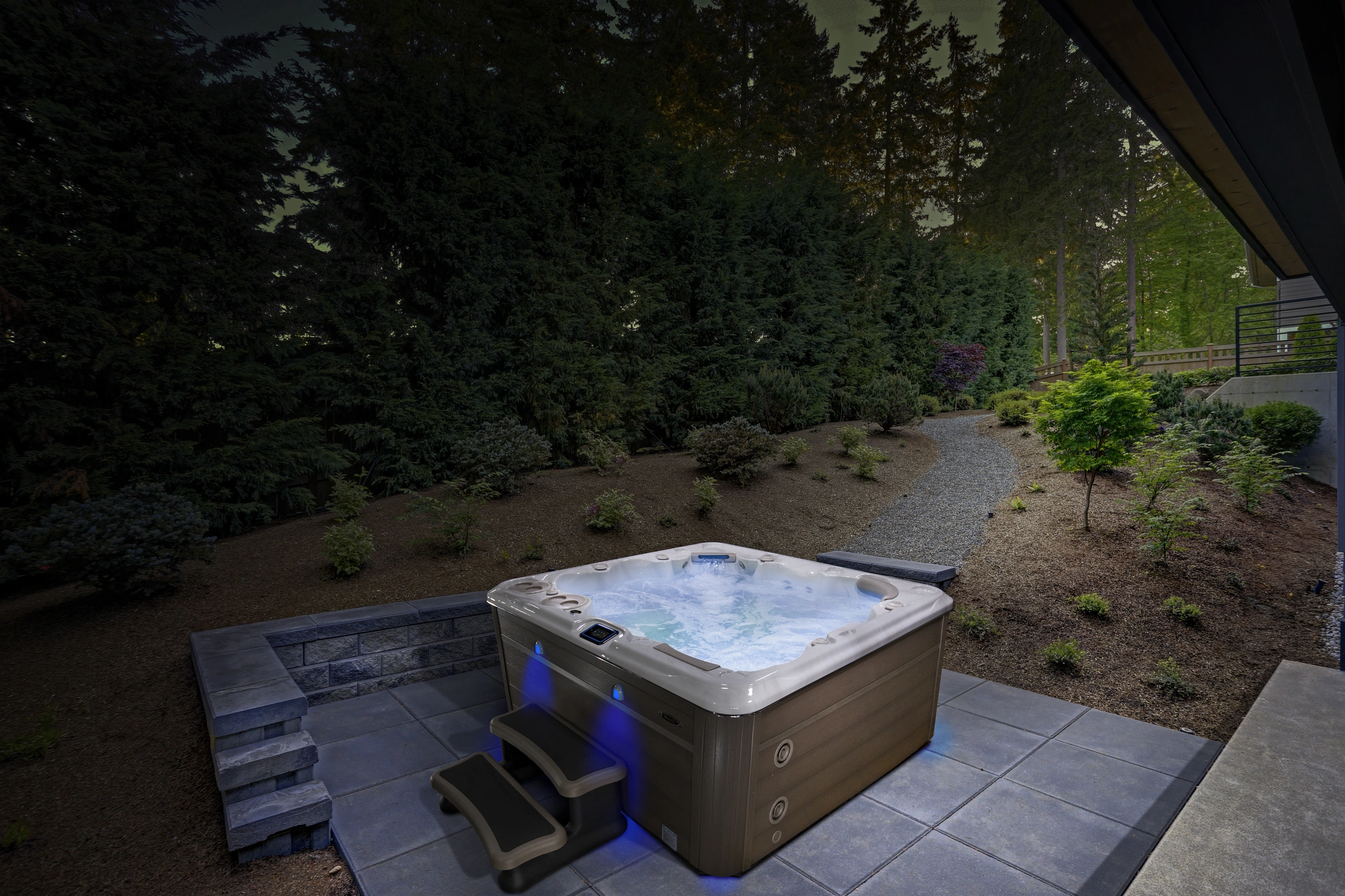Can a Hot Tub Sit on Pavers?

You’re looking at your backyard, knowing exactly where your hot tub will go. The only question in your mind is how little you can pay while getting a solid base for it. Who sees what’s underneath a hot tub anyway?
Can I use pavers? You know, those 24x24 blocks they sell at Home Depot? Or the little bricks? Could I just use those? Maybe I could build a path to it too?
The answer isn’t maybe: The quick answer is that these are all potentially good options. You can use pavers, of varying kinds, underneath your hot tub. But we will say right away that the main concern is making sure the base underneath the pavers is strong enough to support the entire hot tub and won’t shift over time – it’s not usually the pavers themselves. And to build the base, we strongly recommend consulting a professional.
What we have found over the years is that any method of hot tub installation requires a few tips and tricks and pavers are no exception. We are asked about hot tub installations all the time at our Hydropool retail stores, and specifically about using pavers on a regular basis.
So in this article, we will explain why you need something flat, strong and level to support your pavers. We will go over:
- Why do you need a strong, flat base for your hot tub?
- What are some tips to install pavers once the base is built?
- What kind of pavers are available that will work?
By the end of the article, we hope that you’ll have a good idea of what you need to do if you want to pursue pavers as an option for your hot tub base.
Why Do You Need Such a Flat, Strong, Level Base for a Hot Tub?
It is essential to understand just how heavy a hot tub filled with water and bathers can be - think several thousand pounds! The weight of the water places a lot of force on the hot tub shell, so the base for your hot tub must be 100% level.
- If not level, the hot tub shell can eventually stretch and warp, which can cause serious damage to the hot tub.
- In many cases, your warranty will be voided if you have an inappropriate base for your hot tub.
- This is why we so strongly recommend using a professional contractor familiar with hot tubs to build the sand or gravel base underneath any pavers before putting the hot tub on them.
- If your base is not built properly, water running through the ground will cause it to shift over time, making it unlevel and creating a host of problems. You don’t want to have to move your hot tub, dig up your pavers and redo the base a year after the installation. This is the kind of project you want to get right the first time.
Don’t know where to get a professional who can build you a base? Your local retailer will be able to help you find one. Contact them here.
How Much Do Pavers Cost for a Hot Tub?
Many people first consider pavers in the hope they will be less expensive than other options, such as building a deck or placing a concrete pad down (which is our recommendation for the best possible choice).
Pavers aren’t the most expensive option, but they aren’t the least expensive either. A concrete pad is the least expensive choice, while the most expensive choice is usually to submerge the hot tub in the ground.
The cost of the pavers themselves can vary. Basic ones can be as inexpensive as $1 a square foot but can soar up to $20 a square foot (or more) for flagstone of other types of stone.
Notice that doesn’t include the cost of the base itself. The cost of the base can vary greatly depending on the type of soil, slope and location of the hot tub. Look to pay around $1500 Cdn.
Can You Put a Hot Tub on Pavers?
Pavers are attractive and can be used as a hot tub base, with a few precautions. Some pavers are raised in height, and this can impact how level the base is and cause serious problems down the road for your hot tub frame and shell. Again, the base always needs to be level.
Once the professional you have hired has consulted with you on how to put down the gravel and sand, how deep it needs to be for your particular location and how much it needs to be compacted to remain in place. Once that work has been done, putting in the pavers becomes the relatively easy part.
Can I Install the Pavers Myself?
You can put in the pavers yourself or hire someone to do it. Here are some tips if you are doing it yourself:
- If using pavers, select ones with a smooth face and that can be interlocked at a level height to create a solid, flat layer on top of a concrete base. Avoid any paver with a tumbled or other “roughened” effect that will create an uneven surface.
- If you are set on the look of a type of paver that is uneven - don’t worry, these can still be used. Instead of sitting your hot tub on top of the pavers though, we’d suggest placing it on a level concrete slab or using level pavers for the area under the hot tub only. Then install pavers surrounding the hot tub to complete the look you want to achieve. As far as anyone will be able to tell, your hot tub will appear to be on the same style of pavers.
- Measure and plan out any pattern you intend, including pathways, before you begin. Calculate the square feet needed for your area and buy the equivalent amount of paving stones to place (because the size of pavers varies so much, we can’t be more specific than that here).
- Measure and buy 10 percent more than you think you will need. You can always return any extras, and you may need more if you’re doing any unusual patterns or for space.
- Set the pavers in place, being sure that they remain level at the end.
- Once your pavers are set into place, sand needs to be swept into the “joints” between each paver to secure and lock them into place and keep them level. Remember, you don’t want any movement under the hot tub at all. Even a little bit can end up causing you problems.
What Types of Pavers are There?
Here are some of the most common types of pavers that are used in landscaping, driveways and around the home.
- Concrete: a very common type of paver that is durable, versatile and weatherproof.
- Cobblestone: made from natural stone, reminiscent of streets hundreds of years ago.
- Brick: a classic, smooth look and another very popular paver choice. Brick is durable and long-lasting.
- Rubber: made from recycled material, rubber pavers are essentially maintenance free and an excellent choice for hot tubs as they are naturally non-slip.
- Flagstone: cut from stone quarry and incredibly durable. They also do not absorb heat, which makes them ideal for walking on barefoot.
Can You Put a Hot Tub on Pavers?
The answer to that is yes, provided you have a professionally built base supporting the pavers underneath. The base is there to ensure your pavers will remain in place and won’t move with water running through them and the ground below them.
Any movement underneath your hot tub could cause the ground to become uneven, which can lead to warping or other serious issues for your tub. There are a wide variety of pavers available to you as well.
We think pavers can create wonderful looks for hot tub users and have seen many attractive installations using them. So we understand why so many people want to have them in place.
If you have any other questions or concerns about sitting your hot tub on pavers, just ask your local dealer. They can provide all the details you need to ensure that you have a safe location selected to install your hot tub. Find one here.






